Intel Atom D510: Pine Trail Boosts Performance, Cuts Power
by Anand Lal Shimpi on December 21, 2009 12:01 AM EST- Posted in
- CPUs
SYSMark 2007 Performance
Our journey starts with SYSMark 2007, the only all-encompassing performance suite in our review today. The idea here is simple: one benchmark to indicate the overall performance of your machine.
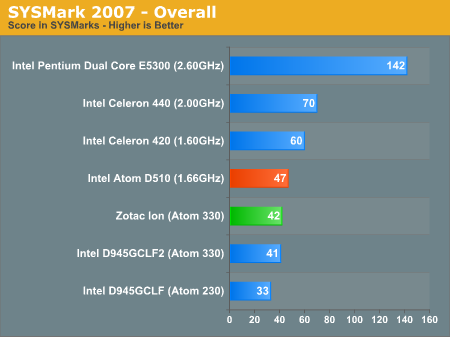
Overall performance of the Atom D510 is roughly 12% faster than the Zotac Ion based on the older Atom 330. We're still shy of the overall performance of a low end Celeron, but much better performance than a single core Atom and a definite improvement over the first generation Atom processor.
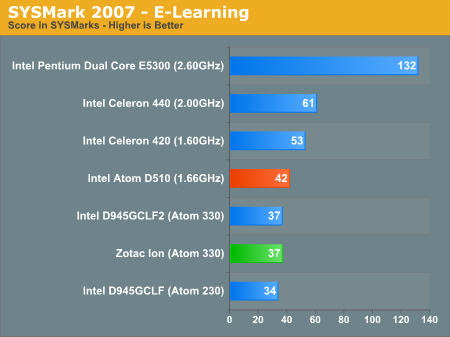
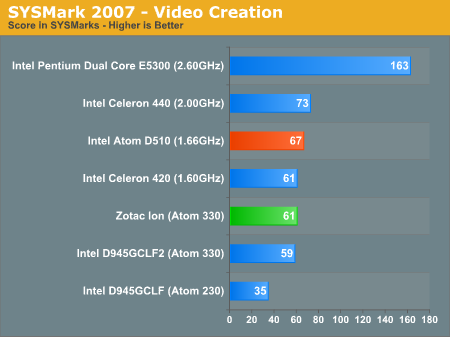
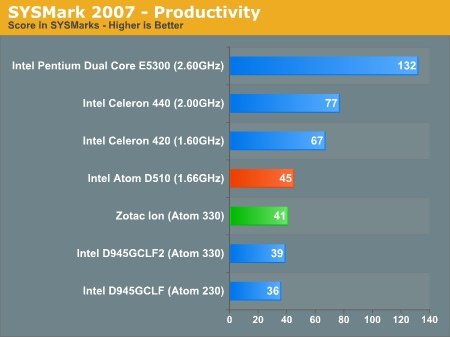
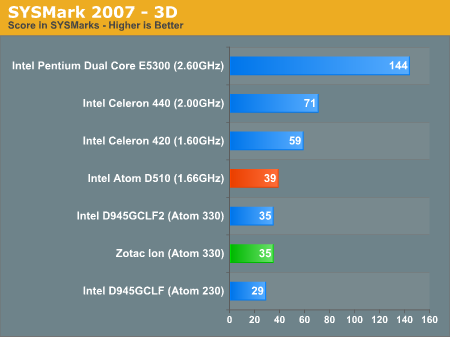
Adobe Photoshop CS4 Performance
To measure performance under Photoshop CS4 we turn to the Retouch Artists’ Speed Test. The test does basic photo editing; there are a couple of color space conversions, many layer creations, color curve adjustment, image and canvas size adjustment, unsharp mask, and finally a gaussian blur performed on the entire image.
The whole process is timed and thanks to the use of Intel's X25-M SSD as our test bed hard drive, performance is far more predictable than back when we used to test on mechanical disks.
Time is reported in seconds and the lower numbers mean better performance. The test is multithreaded and can hit all four cores in a quad-core machine.
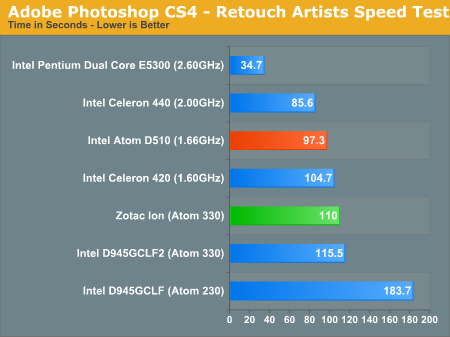
Photoshop performance improved by around 13% compared to Ion/Atom 330. Performance is in the range of a very low end Celeron.










41 Comments
View All Comments
yuhong - Wednesday, December 30, 2009 - link
"Granted the board only costs $75 new, but would it have killed Intel to include DVI or HDMI out?"That is a limitation of the on-die GPU, it only support VGA and LVDS for the display.
lucaiuli - Saturday, January 2, 2010 - link
Found this board at http://www.mini-box.com/D510MO-mini-ITX-Intel">http://www.mini-box.com/D510MO-mini-ITX-Intel, it will be available this week, price is not bad. I am considering buying one and with a Broadcom Crystal HD miniPCI Express card and proper miniITX enclosure it would be a nice fanless and siled HD HTPC for my living room.geok1ng - Tuesday, December 22, 2009 - link
"It’s not a problem in areas where AMD is competitive, but what about areas in which they’re not?"AMD chose not to be competitive on the Netbook and lower power notebook market. There was a time when ATIs IGPs were very good, and today an overclocked 3200 can dish out enough fps to compete with NVIDIAs offerings. AMD had a lower power CPU months before the CLUVs, but it never become an integrated platform like Ion, even on the micro HTPC market.
If a company has a super IGP, and there was a time when AMD had one, and the market has a new wave of low power low costs Netbooks, and this company decides not to join the wave, well, dont blame Intel when things go the way of the Dodo.
I am only seeing Intel paying AMD so that Intel remains dominating the market, even on produtcs were Intel's offerings are so crappy as the IGP market.
Penti - Tuesday, December 22, 2009 - link
AMD still offers the AMD Neo X2 with AMD 785G or HD4200 graphics or with embedded AMD 780E + SB710 chipset. But that's not a netbook offering but a consumer or ultra-portable low-power notebook offer. I don't really like it that it's K8 based but it's still not totally bad. I don't think AMD is interested in the MID/smartphone market Intel is going after slowly any way.There's reason the AMD Neo platform didn't become a HTPC platform, first it was only released with 690E, secondly it wasn't supported in XBMC on linux. Then there's cost. Now CULV makes a lot more sense. GMA4500 is good enough. And it's first now supports really is coming through with Flash acceleration etc. It was a very limited usability with such a platform before. So soon Atom (with Broadcom accelerator), CULV etc really becomes useful and functional in the consumer space. AMD don't have any advantages even if they have support for the same things. I think it's wise that they are designing wholly new mobile products. Then there's gonna be a fair fight. Products will have a lower power envelope and be cheaper and on newer node. More will be released into the market.
killerclick - Monday, December 21, 2009 - link
This could be a chance for VIA Nano to get in on the netbook market. I fear however that most people buying netbooks won't know or care about the difference between the platforms. If it's cheap and can at least play 720p they won't go out of their way to get something non-Intel.Penti - Tuesday, December 22, 2009 - link
I won't consider the Nano until they have shrunk it, made it less power hungry, made it dual core and released a good graphics chip with truly open source drivers. I'd rather have Pineview + Broadcom BCM70015 if not.It's impressive what Centaur can do with ~100 employees, but I'm not impressed with the S3 Graphics or VIA chipset team.
killerclick - Tuesday, December 22, 2009 - link
I meant Nano + ATI/NVIDIA IGPPenti - Tuesday, December 22, 2009 - link
Yeah I know you wrote that. But..That will never happen. It's Nano + Mobile ATI/NVIDIA GPU tops. But I don't see the point. Via's own gpus are fine for DXVA in Windows etc. Nano aren't that power efficient to begin with. It's not like such platforms will be fast enough to game on either way.
This is what they have coming out (chipset with IGP) http://via.com.tw/en/products/chipsets/v-series/vn...">http://via.com.tw/en/products/chipsets/v-series/vn... It's not that bad. It has modern integrated graphics but it can be used with a discrete graphics solution too.
strikeback03 - Monday, December 21, 2009 - link
If I remember correctly, you used a standard ATX power supply for testing the LF/LF2 Atom boards, which you speculated was part of the reason for such high power consumption. Did you restest with the same PSU as from the Pine Trail system?Griswold - Monday, December 21, 2009 - link
Almost no performance gains - the opposite is actually true with the demise of useful chipset graphics for the atom platform.Buh bye, atom! Hello VIA Nano + ION!